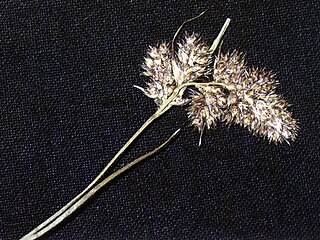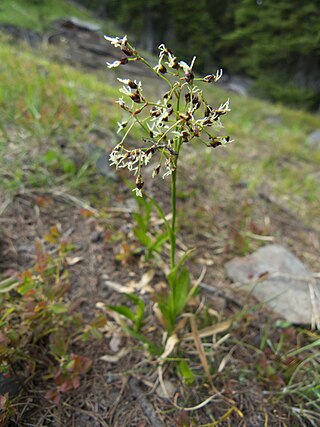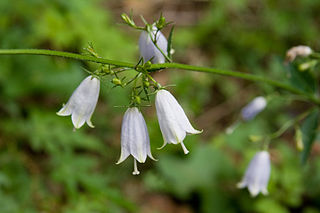
Fagus sylvatica, the European beech or common beech is a large, graceful deciduous tree in the beech family with smooth silvery-gray bark, large leaf area, and a short trunk with low branches.

Luzula is a genus of flowering plants in the rush family Juncaceae. The genus has a cosmopolitan distribution, with species occurring throughout the world, especially in temperate regions, the Arctic, and higher elevation areas in the tropics. Plants of the genus are known commonly as wood-rush, wood rush, or woodrush. Possible origins of the genus name include the Italian lucciola or the Latin luzulae or luxulae, from lux ("light"), inspired by the way the plants sparkle when wet with dew. Another etymology sometimes given is that it does derive from lucciola but that this meant a mid-summer field, or from the Latin luculus, meaning a small place; the same source also states that this name was applied by Luigi Anguillara in 1561.

Primula vulgaris, the common primrose, is a species of flowering plant in the family Primulaceae, native to Eurasia. The common name is primrose, or occasionally common primrose or English primrose to distinguish it from other Primula species referred to as primroses.

Araujia sericifera is a perennial vining plant in the genus Araujia, of the family Apocynaceae, that is native to South America. The species was described in 1817 by the Portuguese botanist Félix de Avelar Brotero. The synonym Araujia hortorum is in more frequent use in New Zealand. Its common names include bladderflower, white bladderflower, bladder vine, cruel vine, cruel plant, moth plant, moth vine, common moth vine, and false choko.

Luzula comosa is a species of flowering plant in the rush family known by the common name Pacific woodrush. It is native to western North America from Alaska to California to Colorado, where it can be found in moist spots in forests and meadows and many other types of habitat. It is a perennial herb quite variable in appearance, often forming small, narrow grasslike tufts. The erect inflorescence is tipped with a series of clustered spikelike flowers. The dark brown perianth parts open to reveal 6 stamens tipped with large anthers.
Luzula divaricata is a species of flowering plant in the rush family known by the common name forked woodrush. It is native to the California and Nevada in the United States.
Luzula orestera, with the common name Sierra woodrush, is a species of flowering plant in the rush family. It is endemic to the High Sierra Nevada of California, where it grows in fellfields, talus, and other habitat in regions of subalpine and alpine climates.

Luzula parviflora is a species of flowering plant in the rush family known by the common name small-flowered woodrush. It has a northern circumboreal distribution.

Luzula spicata is a species of flowering plant in the rush family known by the common name spiked woodrush. It has a circumpolar distribution, occurring throughout the northern Hemisphere in Europe, Asia, and North America. It grows in subalpine and alpine climates. It occurs at low elevations in colder regions, such as tundra; farther south it is restricted mainly to high mountains. It is a perennial herb forming grasslike clumps of several erect, reddish stems up to about 33 centimeters in maximum height. The stem is thick and its base is buried several centimeters in the soil where it attaches to the roots. The inflorescence is an array of several clusters of brown bristle-tipped flowers. The surrounding bracts and the sheaths surrounding the leaf bases are lined with hairs.

Luzula multiflora, the common woodrush or heath wood-rush, is a species of flowering plant in the rush family.

Luzula pilosa is a species of flowering plant in the rush family Juncaceae with the common name hairy wood-rush. The plant is native to northern Europe and western Asia.

Coleophora sylvaticella is a moth of the family Coleophoridae found in Europe.

Luzula hitchcockii is a species of flowering plant in the rush family known by the common names smooth woodrush and Hitchcock's wood rush. It is native to western North America from British Columbia and Alberta to Oregon to Wyoming. It is sometimes treated as a variety of Luzula glabrata.

Luzula acuminata, the hairy woodrush, is a species of perennial flowering plant in the rush family, Juncaceae, that is native to the Eastern United States and Canada. It is 6–47 centimetres (2.4–18.5 in) tall with its basal leaves being of 6–39 centimetres (2.4–15.4 in) high and 2–11 millimetres (0.079–0.433 in) in diameter. It has cauline leaves are 2.5–11.5 centimetres (0.98–4.53 in) tall and 2–5 millimetres (0.079–0.197 in) wide.

Luzula pallescens is a species of perennial plant in Juncaceae family, commonly known as fen wood-rush.
Luzula nivalis, commonly known as arctic wood-rush or less commonly as snowy wood-rush, is a species of perennial rush native to the North American Arctic and Northern Europe. It was described by Polunin (1940) as one of the most abundant, ubiquitous, and ecologically important of all arctic plants.

Luzula nivea, commonly known as snow-white wood-rush, snowy wood-rush and lesser wood-rush, is a species of perennial plant in Juncaceae family.

Adenophora triphylla, also known as Japanese lady bell, is one of the 62 species of Adenophora. It is a flowering plant in the family Campanulaceae that is distributed mainly over the Korean Peninsula, Japan, and China.
Luzula wahlenbergii, commonly known as Wahlenberg's woodrush or reindeer wood-rush, is a perennial species of plant in the genus Luzula of the (rush) family Juncaceae.
Luzula piperi, commonly known as Piper's woodrush is a perennial species of plant in the genus Luzula of the (rush) family Juncaceae. Luzula piperi is native to northwestern North America and eastern Asia.
















